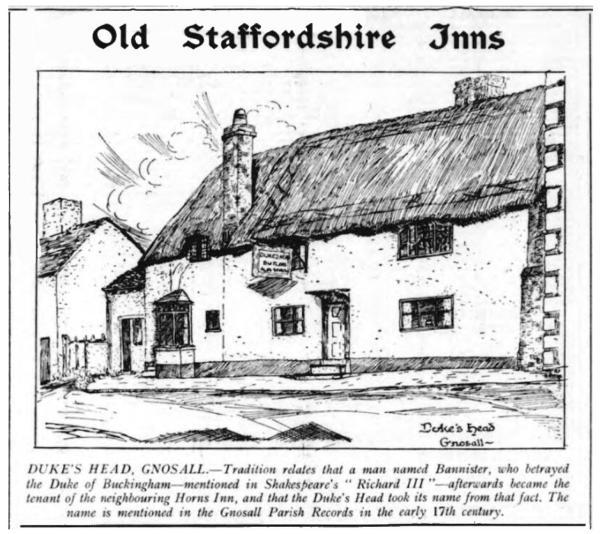Origin of ‘The Horns’ 1484
This following story is told on a large, faded and stained, hard to read handwritten document in the William Salt Library. It’s
probably 19
th
century but it’s set at the time of Richard III, and says it’s taken from an old History of England.
“Banister’s wife left him and eloped with an Officer in the Army. Soon after his property was sold to pay his debts.
Banister then went to a village called Gnosall in Staffordshire, and kept a Pot House, and which he named “The Horns” in
allusion to his wife’s infidelity as well as to draw company to the House, he exhibited a large pair of Deer’s Horns.
In this situation Banister continued a few years and then was publicly executed at Stafford for Manslaughter.
His oldest son became insane, - his second son became lame and deformed, - his youngest son was drowned in a small
water well near the Horns at Gnosall, - his youngest daughter was seized with the agy of which she died, - his eldest
daughter became pregnant by a Carter most of whose offspring have been vagabonds and paupers to this day.”
Henry Stafford, Duke of Buckingham marched from Wales to England with a large force of Welshmen to overthrow
Richard III in 1483. His advance was stopped by an extraordinary flood on the Severn. His army melted away without
striking a blow, and he himself took refuge with a servant, Ralph Banister. King Richard offered £1000 to anyone who
would turn Stafford in.
Banister, on hearing the King’s Proclamation offering betrayed his Master who was in the disguise of a peasant to the
High Sheriff for Shropshire, who arrested Stafford and sent him under a strong escort to the King at Salisbury where he
was beheaded in the Market place the next day on 22
nd
November.
Banister who on demanding the £1000, the price of his Master’s Blood was refused (for the wicked seldom find as they
seldom exert friendship) by King Richard saying “he who could betray so good a master, would be unfaithful to any other”.
It’s said that “Banister and his whole family were destroyed by the surprising judgments of the Almighty.”
Details so far are well documented. The name of the High Sheriff for Shropshire has been shown as either ‘John’ or
‘Thomas’ Mytton Esq. and the place where Banister lived has been quoted as ‘Lacon Hall, Wem’, ‘Shinewood, near
Wenlock’, ‘Hay-Gate near to Shrewsbury’, or further away in Forest of Dean.
What happened to Banister becomes interesting. Two items have emerged. The reader must make up their own mind as
to the authenticity.
This article appeared in the
Staffordshire Advertiser dated
23 November 1946.
It’s original source is unknown.

V VVVVVVVVVVVVVVVVVVVVVVVV
Click above for home screen




















